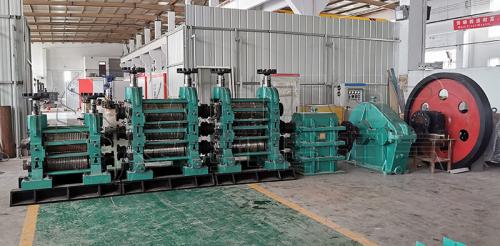Main Process Characteristics of High-Speed Wire Rod Rolling Mill

A high-speed rolling mill generally refers to a rolling mill with a
maximum rolling speed higher than 40m/s. Therefore, when the maximum rolling
speed of a wire rod rolling mill is faster than 40m/s, it is called a high
sheath rolling mill. The characteristics of the high-speed wire rod mill are:
high speed, single wire, no torsion, slight tension, combined structure,
calcium carbide spoke ring, and automation. Its products are of large discs,
high precision, and good quality. Improving the rolling speed of the wire rod
mill is the trend and the key to the development of the wire rod mill.
Increasing the rolling speed of the rolling mill can increase the output of the
rolling mill, increase the coil weight and reduce the cost.
Focusing on the problems caused by the increase in speed, various
types of high-speed wire rod mills have been researched from the perspective of
realizing torsion-free rolling and reducing mill vibration. After the disk
weight increases, the inner layer wire stays at a high temperature, forming
coarse grains, which makes the performance of the inner and outer rings very
different. Controlled cooling is required to solve this problem.
High speed, no torsion, and controlled cooling are the main
technological features of modern high-speed wire rod mills:
1. High-speed rolling: the rolling speed of an ordinary continuous
wire rod rolling mill is generally below 35m/s, and the rolling speed of a
double-double rolling mill is about 16m/s. And the rolling speed of the
high-speed wire rod mills currently in use is mostly above 75m/s, and the
higher rolling speed has reached 120m/s, even 140m/s;
2. Twist-free rolling: the finishing rolling unit of a general
high-speed wire rod mill consists of 8 to 10 stands, single-wire rolling, and
the rolling is cantilever type, adjacent to the stands;
3. Cooling: Due to the high rolling speed and heavy disk of the
high-speed wire rod mill, it is not acceptable to adopt the method of directly
collecting coils. On the high-speed wire rod rolling mill, the rolled piece
comes out of the finishing mill and directly enters the water cooler for rapid
cooling, and then through the laying machine, the wire rod is scattered in a
controlled manner on the conveyor for coil cooling, generally using air
cooling, and finally, Air cooling is natural cooling. Controlled cooling is not
only to cool down the temperature quickly, prevent the formation of secondary
oxide scale and make the structure uniform but more importantly, to control the
structure and performance of the wire. Therefore, the processing system for
controlling each section of cooling is determined by the microstructure and
performance requirements of the steel type of the rolled wire rod;
4. Low-temperature rolling and controlled rolling: Due to the high
rolling speed, the temperature not only does not decrease but rises during the
rolling process, so the rolling start temperature can be reduced to achieve
low-temperature rolling. The temperature of each section is controlled by
setting water coolers at different positions to carry out controlled rolling.
Under such equipment and process conditions, the high-speed wire rod
mill has high output, heavy coil, high product precision, good surface quality,
and excellent microstructure.
Post Your Ad Here
Comments